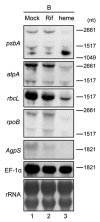Retrograde signals arise from reciprocal crosstalk within plastids
- PMID: 22301982
- PMCID: PMC3357356
- DOI: 10.4161/psb.7.1.18451
Retrograde signals arise from reciprocal crosstalk within plastids
Abstract
In addition to the cell nucleus, plant cells also possess genomic DNA and gene expression machineries within mitochondria and plastids. In higher plants, retrograde transcriptional regulation of several nuclear genes encoding plastid-located proteins has been observed in response to changes in a wide variety of physiological properties in plastids, including organelle gene expression (OGE) and tetrapyrrole metabolism. This regulation is postulated to be accomplished by plastid-to-nucleus signaling, (1,2) although the overall signal transduction pathway(s) are not well characterized. By applying a specific differentiation system in tobacco Bright Yellow-2 (BY-2) cultured cells, (3,4) we recently reported that the regulatory system of nuclear gene expressions modulated by a plastid signal was also observed during differentiation of plastids into amyloplasts. (5) While retrograde signaling from plastids was previously speculated to consist of several independent pathways, we found inhibition of OGE and perturbation in the cellular content of one tetrapyrrole intermediate, heme, seemed to interact to regulate amyloplast differentiation. Our results thus highlight the possibility that several sources of retrograde signaling in plastids could be integrated in an intraorganellar manner.
Figures

Comment on
- Enami K, Ozawa T, Motohashi N, Nakamura M, Tanaka K, Hanaoka M. Plastid-to-nucleus retrograde signals are essential for the expression of nuclear starch biosynthesis genes during amyloplast differentiation in tobacco BY-2 cultured cells. Plant Physiol. 2011;157:518–30. doi: 10.1104/pp.111.178897.
Similar articles
-
Plastid-to-nucleus retrograde signals are essential for the expression of nuclear starch biosynthesis genes during amyloplast differentiation in tobacco BY-2 cultured cells.Plant Physiol. 2011 Sep;157(1):518-30. doi: 10.1104/pp.111.178897. Epub 2011 Jul 19. Plant Physiol. 2011. PMID: 21771917 Free PMC article.
-
Intracellular signaling from plastid to nucleus.Annu Rev Plant Biol. 2013;64:559-82. doi: 10.1146/annurev-arplant-050312-120147. Epub 2013 Feb 4. Annu Rev Plant Biol. 2013. PMID: 23394498 Review.
-
Retrograde signaling pathway from plastid to nucleus.Int Rev Cell Mol Biol. 2011;290:167-204. doi: 10.1016/B978-0-12-386037-8.00002-8. Int Rev Cell Mol Biol. 2011. PMID: 21875565 Review.
-
Plastid-to-nucleus retrograde signaling.Annu Rev Plant Biol. 2006;57:739-59. doi: 10.1146/annurev.arplant.57.032905.105310. Annu Rev Plant Biol. 2006. PMID: 16669780 Review.
-
Bilateral communication between plastid and the nucleus: plastid protein import and plastid-to-nucleus retrograde signaling.Biosci Biotechnol Biochem. 2010;74(3):471-6. doi: 10.1271/bbb.90842. Epub 2010 Mar 7. Biosci Biotechnol Biochem. 2010. PMID: 20208345 Review.
Cited by
-
Changes in plastid biogenesis leading to the formation of albino regenerants in barley microspore culture.BMC Plant Biol. 2021 Jan 7;21(1):22. doi: 10.1186/s12870-020-02755-z. BMC Plant Biol. 2021. PMID: 33413097 Free PMC article.
References
-
- Miyazawa Y, Sakai A, Miyagishima S, Takano H, Kawano S, Kuroiwa T. Auxin and cytokinin have opposite effects on amyloplast development and the expression of starch synthesis genes in cultured bright yellow-2 tobacco cells. Plant Physiol. 1999;121:461–9. doi: 10.1104/pp.121.2.461. - DOI - PMC - PubMed
-
- Enami K, Ozawa T, Motohashi N, Nakamura M, Tanaka K, Hanaoka M. Plastid-to-Nucleus Retrograde Signals Are Essential for the Expression of Nuclear Starch Biosynthesis Genes during Amyloplast Differentiation in Tobacco BY-2 Cultured Cells. Plant Physiol. 2011;157:518–30. doi: 10.1104/pp.111.178897. - DOI - PMC - PubMed
MeSH terms
Substances
LinkOut - more resources
Full Text Sources
